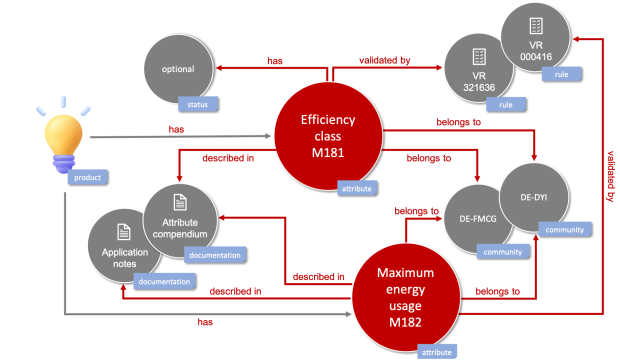
parson advises GS1 Germany on the use of knowledge graphs for product information and documentation
GS1 Germany opts for a content management solution using semantic tools for target group-oriented and standardized documentation.
The challenge: Large documents and poorly comprehensible relations
Vivian Salim, Master Data + Data Exchange Manager at GS1 Germany: "Up to now, we have maintained the GDSN data specifications in a central Excel file. In the GDSN, the various data elements are interrelated, which is difficult to map in the Excel file. Keeping the specification up-to-date becomes challenging as a result. For GDSN users, we also create additional documentation in Word, which is published in the form of a PDF. In turn, users have difficulties finding the information they need on the various data elements in the different documents and understanding all the relations."
The goal: Digitalize technical documentation
Vivian Salim, Master Data + Data Exchange Manager at GS1 Germany: "Our aim is to enhance the creation and management of GDSN data and specifications while delivering more user-friendly and targeted documentation to our customers. We also want to digitalize and partially automate the documentation processes."
The solution: Semantic content management and standardized, target group-oriented documentation
Recommendation for a knowledge graph and suitable providers
Ulrike Parson, Project Manager: "Our recommendation for GS1 Germany is to use a knowledge graph for mapping and managing the semantic GDSN data along with their relations. The system will also be used to create and deliver documentation content related to data elements. In the first phase of the project, we defined the detailed requirements for the system, identified potential system providers, and evaluated the systems together with GS1 Germany."
Analyze target groups and derive information needs and content types
Frank Ralf, Senior Technical Consultant at parson: "Besides the technical solution, the documentation will also be made more suitable for the target groups. Initially, we conducted a survey among documentation users to identify the target groups for the different information products. We used interviews and surveys to determine what information the target groups need. Based on the results, we were able to determine the required content types for the documentation."
Terminology and writing rules for standardized documentation
Esther Strauch, Technical Communicator at parson: "I supported GS1 Germany in developing the company terminology, writing rules, and an editorial guide. We passed on our expert knowledge on standardized documentation to GS1 Germany through training courses. We also implemented some of the identified information types and writing rules for selected documentation content."
Proof-of-concept for semantic database
Christian Przybilla, Lead Master Data + Data Exchange at GS1 Germany: "With parson's support, we were finally able to decide on a knowledge graph system provider. In the next step, we will test the system for its suitability in a proof-of-concept."
Jonas Wäckerle, Senior Technical Consultant at parson AG: "During the proof-of-concept, we thoroughly tested the system and the planned information architecture and further specified the requirements of GS1. This gave us a clear picture of how the requirements can be implemented in the system and what is to be expected for the GS1-specific implementation."
Next step
In the next step, parson will support GS1 in the implementation of the semantic database, the modelling of the knowledge graph, and the completion of the information architecture. All data and documentation content needs to be imported into the system in a structured way and linked.
After a foundation for the data has been created, the various GS1 use cases (e.g. editorial processes, output) will be implemented iteratively by the system manufacturer. parson will support GS1 to further specifiy the requirements and in the medium-term planning up to the rollout of the system.
About GS1 Germany
The GS1 Global Data Synchronisation Network (GS1 GDSN) is the world's largest product data network. GS1 GDSN makes it possible for any company, in any market, to share high-quality product information seamlessly. Because companies of all sizes need the same thing – timely and reliable product information – to ultimately benefit consumers and patients.
GS1 GDSN makes it possible for any company, in any market, to share high-quality product information seamlessly. Because companies of all sizes need the same thing – timely and reliable product information – to ultimately benefit consumers and patients.
In Germany, GS1 Germany is responsible for developing and updating the German GDSN target market profile.

